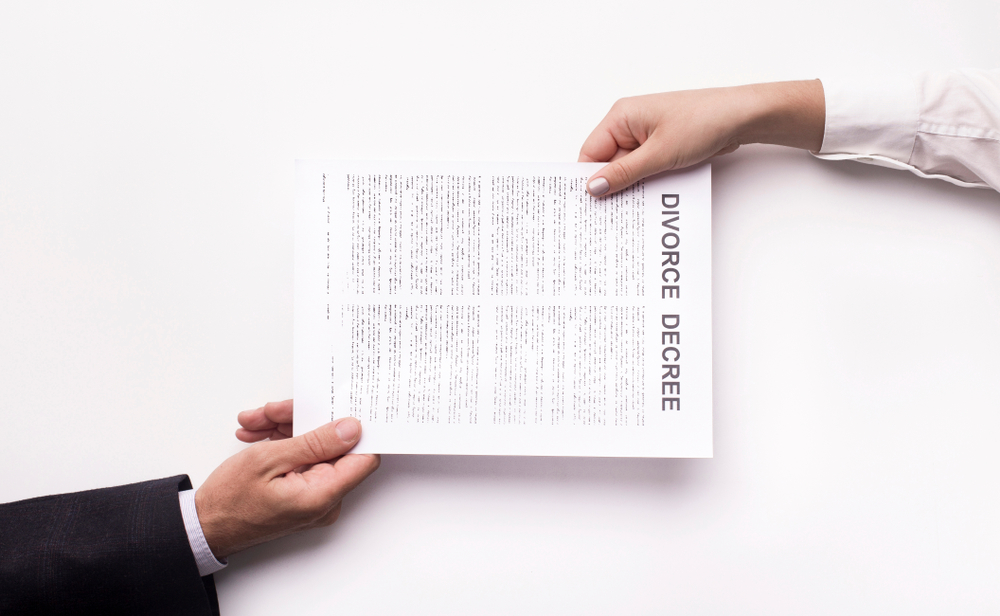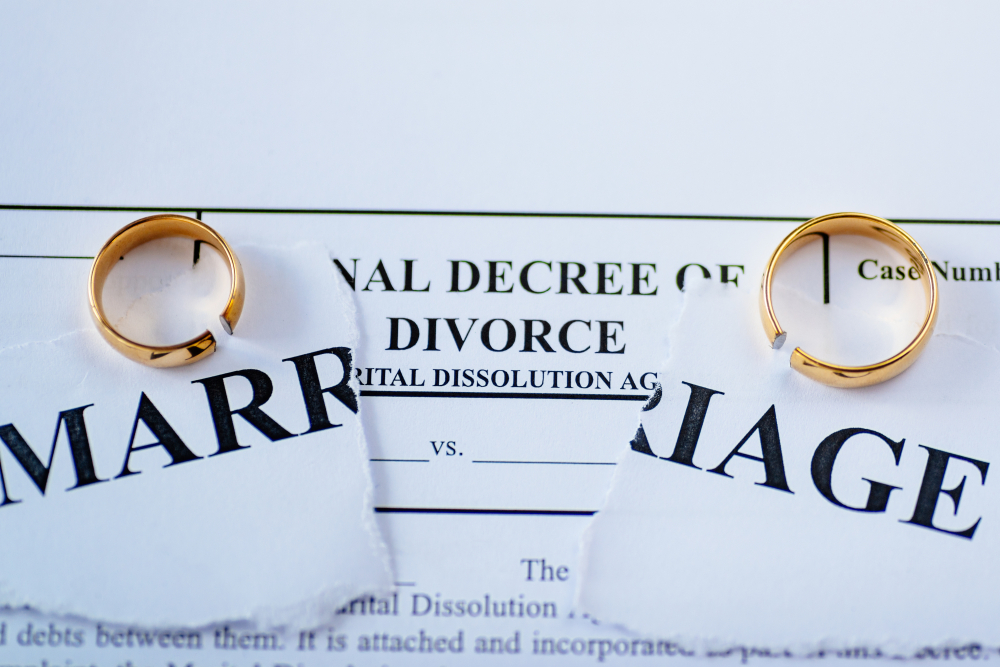What does a divorce paper look like? This is a common question among couples that decide to end their marriage. Serving divorce papers is the legal way for a spouse to notify the other spouse that they have begun the divorce process. The spouse receiving divorce papers has a chance to file a response. Let’s look at how the process works and the forms you need to file to start a divorce in California.
Service or service of process
In divorce cases, ‘service of process’ or ‘service’ refers to providing the spouse a copy of all complaints, petitions, and motions in a manner required by the law. The service of process keeps both spouses in the know about the divorce proceedings and give them the opportunity to respond and participate.
The summons and complaint for divorce (called the ‘petition’) are the initial documents filed in a divorce proceeding. In the complaint, you request the court to grant your divorce, divide your marital property, determine child custody, and calculate child and spousal support. The summons informs the non-filing spouse about which court will hear the case and how to respond to the complaint.
When you file the divorce petition, the court clerk will keep a copy and give you an official stamped copy to serve your spouse. You’re legally obligated to serve this paperwork to your spouse.
Forms to start a divorce
After filing your California divorce papers with the court clerk, serve the following blank divorce forms to your spouse:
- Response — Marriage/Domestic Partnership (Form FL-120): This form requests basic information about your marriage and the type of orders you want the court to make.
- Declaration Under Uniform Child Custody Jurisdiction and Enforcement Act (UCCJEA) (Form FL-105/GC-120): You need this form if you have children under 18 years old with your spouse. The form tells the court where your children were born, where they live, and whether there are any court cases involving them.
Once completed, ensure the process server includes copies of these filed and stamped forms in the service of process:
- Petition — Marriage/Domestic Partnership (Form FL-100): This form starts the divorce. You must state all the issues you wish to include in your final divorce.
- Summons (Family Law) (Form FL-110): Informs your spouse that a court case has started and what can happen if they don’t file a response within 30 days. Page 2 of the form contains important orders that both sides must follow.
- Property Declaration (Family Law) (Form FL-160): This is an optional form you can attach to your petition if you need to list more of your properties and debts. List all your properties and debts in the form, stating whether you think each is a community or separate property.
- Child Custody and Visitation (Parenting Time) Application Attachment (Form FL-311): This is an optional form if you have children together. It helps ensure you don’t leave anything out of your request. If you use it, attach it to your Petition, FL-100.
The spouse that first filed divorce papers must share financial information with their spouse. If the spouse files a response, they must share their financial information. If they do not file a response but want the court to approve an agreement, they must also share their financial information.
A number of financial disclosure forms need to be served to the responding spouse, including the
Declaration of Disclosure (Form FL-140), Income and Expense Declaration (Form FL-150), Schedule of Assets and Debts (Form FL-142)/Property Declaration (Form FL-160), and the divorce settlement agreement.
Depending on your case, you may need to file additional documents. A divorce attorney will help you complete, file, and serve divorce paperwork. The Law Offices of Heath L. Baker have years of experience working with contested divorce, annulment, alimony, property and debt division, divorce mediation, and other cases. We take care of divorce paperwork and advise you on resolving as many contentions as possible.
The full list of California divorce papers
- FL-100: Petition
- FL-105: Declaration Under the Uniform Child Custody Jurisdiction and Enforcement Act
- FL-110: Summons
- FL-115: Proof of Service of Summons
- FL-330: Proof of Personal Service
- FL-335: Proof of Service by Mail
- FL-117: Notice and Acknowledgment of Receipt
- FL-120: Response
- FL-130: Appearance, Stipulations, and Waivers
- FL-140: Declaration of Disclosure
- FL-141: Declaration Regarding Service of Declaration of Disclosure and Income and Expense Declaration
- FL-142: Schedule of Assets and Debts
- FL-144: Stipulation and Waiver of Final Declaration and Disclosure
- FL-150: Income and Expense Declaration
- FL-170: Declaration for Default or Uncontested Dissolution or Legal Separation
- FL-180: Judgment
- FL-182: Judgment Checklist
- FL-190: Notice of Entry of Judgment
Use a process server
In California, the petitioning spouse cannot directly serve divorce papers to the responding spouse. The petitioning spouse must arrange for someone over the age of 18 who is not a party to the divorce proceedings, to act as the process server. This could be your friend, relative, or a hired process server. If you hire a divorce attorney, they will handle the technical details of filing documents with the court and serving your spouse.
There are different modes of serving divorce papers, as explained below:
Mail: The process server mails the documents to the other spouse. They must attach two blank copies of the Notice and Acknowledgment of Receipt (Family Law) (Form FL-117).
Personal service: An individual over the age of 18 not involved in the divorce hands over the papers to the other spouse at any location. They identify themselves as the process server for the petitioning spouse. If the spouse does not want to be served, the process server can leave the divorce papers on the ground.
Substituted service: The process server gives the papers to someone at the other spouse’s residence or workspace. This method usually comes into play when the other spouse has avoided being served by the process server and other means of contacting the spouse have been exhausted.
Publication: The notice can even be published in a public place, typically, in a newspaper in the responding spouse’s area. This is quite uncommon.
Post: If your spouse avoids being served, you can have a California court post the notice at a courthouse. To serve by posting, you must qualify for a court fee waiver. Check with your divorce attorney to understand if you can use this option for your divorce case.
Out-of-state spouse: The spouse can be served by mail.
Spouses have 30 days to respond to divorce papers, failing which, they will lose their right to speak in front of a judge regarding their divorce. The divorce papers will be sent to the judge for approval.

What do you do when you’re served divorce papers in California?
Go through the documents thoroughly and note the actions you will need to take. Seek legal advice to understand what you’re required to do. Your divorce attorney will guide you on the process and recommend the best course of action.
How do you know the papers are real?
While being served fake divorce papers is in poor taste, it’s a good idea to validate the authenticity of any legal papers you’re served, including divorce papers. So, what does a genuine divorce paper look like? You can verify the information as being accurate. The papers will have the court’s letterhead and stamp, a hearing date, and the actions that must be taken, along with information on how to proceed. If these details are absent, it’s possible that the papers are fake.
Note that errors in information are not uncommon. If you spot inaccuracies in the divorce papers, there’s a chance that the petitioning side did, in fact, make errors unknowingly or intentionally. If you’re unsure, consult a divorce lawyer at the earliest.
Filing a joint divorce petition
Divorce can be a complex and emotionally challenging process. Filing a joint petition for dissolution of marriage can help divorcing spouses save time, cost, and reduce the stress of the process. It is suggested for when both parties are willing to work together to finalize the divorce.
To file a joint divorce petition, both spouses must meet certain requirements:
- At least one spouse must have resided in California for a minimum of six months, and in the county where the petition is filed, for a minimum of at least three months.
- Both spouses must meet a mutual agreement on all aspects of the divorce, covering division of marital property and debt, spousal support, and child support. The marital settlement agreement can be typed out and attached to the Joint Divorce Petition.
- There must be no history or allegations of domestic violence between the spouses.
Steps to file a Joint Divorce Petition
- Both spouses must prepare and organize the necessary documents, including financial statements, property deeds, and custody agreements.
- The petition must be crafted in compliance with California law, and include all information related to the divorce.
- Both spouses must sign the petition in the presence of a notary public to validate the document.
- The document must be filed with the court in a court where either spouse resides.
- The non-filing spouse must be served with a copy of the petition and a summons, which will explain their rights and responsibilities during the divorce process.
- The non-filing spouse has 30 days to respond to the petition. If the spouse agrees, then they can sign and submit a waiver of response.
- If both parties agree to the terms of the divorce, then the court will approve the petition and the divorce will be finalized.
Online divorce in California
Can you complete your divorce online in California? Online divorce is legal in California, and an option if you and your spouse agree on all terms of your divorce. It is often the quickest route to a divorce as you have nothing to fight over. However, note that there is a mandatory six-month waiting period between divorce filing and judgment for marriage dissolution.
If you have significant marital assets or cannot agree on everything, a divorce attorney can help ensure your divorce is uncontested. Online divorce also does not work when one spouse is seeking alimony.
Steps to get an online divorce in California:
- Meet online divorce filing requirements: You must meet the residency requirements and your divorce must be uncontested.
- Prepare and file your paperwork: Fill the necessary online divorce papers, first locating your court and referring to California’s self-help divorce guides to understand the paperwork process. File your documents and pay court filing fees (or apply for a fee waiver).
- Serve papers to your spouse: Choose a process server (someone you know or a professional service) or ask the county sheriff’s office, which will charge you a small fee for the service.
- Complete the cooling-off period: During the six-month statutory waiting period, you can expect to stay busy with a few tasks. They include exchanging financial information with your spouse, creating a settlement agreement, and making decisions about child custody, visitation, and support.
- Finalize your divorce: At the end of the waiting period, finalize your separation. Fill out the judgment (divorce decree) and submit to the court. If it is acceptable, the judge will sign and your divorce will be final. In case the judge has any questions, they may ask them or schedule a hearing to get a clarification.
You don’t have to go it alone
In California, you have the right to be your own lawyer in all cases. But divorce being tricky and more so when kids are involved, make sure you exercise sound judgment every step of the way. The counsel of a divorce attorney, who can serve as a mediator or take you through a quick formal trial, can be invaluable.
The Law Offices of Heath L. Baker have a strong track-record of helping spouses come to a mutual settlement, saving them time, money, and emotional turmoil. We make a divorce easier, enabling you to move on as quickly as possible for your situation. If you want to obtain a divorce from your spouse or you’ve been served divorce papers, contact us right away.

